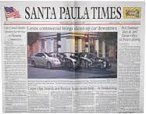SP firefighters still out: Supervisors
want answers in SCWW explosions
February 13, 2015
By Peggy Kelly
Santa Paula News
The Ventura County Board of Supervisors did not renew the emergency declaration sparked by the November 18 explosions at Santa Clara Waste Water but they’ll be looking for their approximately $660,000 in costs - as well as about $600,000 for a new fire engine - in coming weeks.
But, supervisors are also looking for answers about the explosions that also cost Santa Paula Fire not only a fire engine but also harmed the health of three firefighters.
Santa Paula Fire engine personnel are still recovering from chemical exposure injuries they suffered November 18 when they responded as mutual aid to the 3:45 a.m. reports of the explosion at Santa Clara Waste Water where they - as well as Ventura County Fire personnel - were repeatedly assured that a vacuum truck explosion did not involve hazardous materials.
It was about 30 minutes later that a third person at the scene told firefighters they believed hazardous material might be involved, chemicals that the company told a county newspaper Monday was sodium chlorite.
That was news to county staff that told supervisors at their Tuesday meeting that although SCWW representatives had told them what the substance was the previous week they had yet to submit a written statement as requested.
Resource Management Director Chris Stephens told supervisors Tuesday “I read in the paper this morning that the operator issued a written statement indicating the cause was an accidental mixture of sodium chlorite and septic waste... unfortunately, the county did not receive a copy of that statement so we were caught off guard.”
In fact, in the months since the explosion at the still closed facility at Mission Rock Road outside Santa Paula city limits, officials have repeatedly said testing has not revealed what first exploded out the back of a vacuum truck, critically injuring a SCWW employee and also harming a Patriot Environmental Solutions staffer at the scene.
Unaddressed by any officials publicly is why what would seem to be a normal function was taking place at SCWW at that time of the morning, an issue that neighbors had been complaining to the county about for more than a year. The permit for the facility only allows business outside normal business hours for emergencies and other special circumstances.
Stephens told the board although SCWW officials a week ago “verbally indicated” the cause of the initial explosion, a requested written report had not yet been submitted, that, “I think is just a crossing of the wires... “
The meeting, he noted was to establish the “ground rules for how and if,” SCWW will be able to regain its permit which also relies on the City of Oxnard allowing the company to use its waste water treatment plant reached via a pipeline.
Oxnard shut off its access valve to SCWW a few days after the explosion noting the action was primarily based on multiple readings of radioactivity above acceptable levels.
Company officials claim the readings, which were taken over a three-month period before the explosion, were flawed.
According to a SCWW report to Oxnard, on November 20 SCWW officials, “requested an immediate meeting” with the Oxnard wastewater maintenance manager “to self-report that the company had just found reason to believe that some reports to the City had been filed erroneously and that the responsible person had been placed on administrative leave.”
Supervisors were told Tuesday that under the direction of Oxnard about 60,000 gallons of waste was flushed from the 12-mile long pipeline, is contained and being tested.
Rick Bandelin of VC Environmental Health said the company had not reported it had sodium chlorite on site, which has a 30-day reporting period.
The facility was inspected by the county November 5 and the substance was not reported; sodium hydro-chlorite did appear on an inventory listing done by the Environmental Protection Agency following the explosion.
Whatever it was that exploded out the rear of the vacuum truck that morning spewed about 1,200 gallons of liquid that crystallized and ignited after it dried.
Several hours later there was a second explosion on the site when a vapor cloud ignited that caught chemical bins on fire including sulfuric acid. That fire, which emergency personnel were forced to let burn because of the unknown nature of the chemicals that caused it, created a three-mile plume of hazardous smoke. The incident caused evacuations, Briggs School emptied and about 55 people - including the SPFD personnel - treated for injuries. It is estimated $1 million was lost in crops. A half-mile evacuation perimeter was kept in place for days.
Stephens told supervisors although the facility is closed SCWW is doing general “housekeeping” cleanup and repairs that will be updated on a county’s webpage.
He added SCWW’s operating permit would not be reactivated until the company submits a “very thorough explanation of what happened” that caused the explosion, a safety plan for preventing another such incident and Oxnard reinstating the pipeline contract.
Board Chair Supervisor Kathy Long - who represents Santa Paula - and a majority of supervisors expressed their impatience in determining the exact cause of the explosions.


